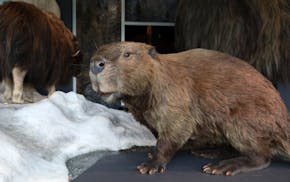Owl is not well, Minnesota.
Injured birds kept arriving at the Raptor Center at the University of Minnesota. Owl after owl after owl. Five in the space of one September week — hurting, hooting, some still cocooned in bits of soccer net.
Even for an institution dedicated to helping ill and injured birds of prey, it was an owl-full week.
So far this year, the Raptor Center has disentangled six great horned owls, three barred owls, a red-tailed hawk and one broad-winged hawk from netting. Not all of them survived the encounter.
It was a snapshot of one particular owl that pushed the issue onto our social media feeds and into our hearts. If you've scrolled Facebook this month, you've probably been glared at by this bird. A juvenile great horned owl, hopelessly snarled in a west metro soccer net, narrowing its eyes at the camera as if it could not believe this human nonsense.
Athletic fields are "kind of a perfect-storm situation" for young birds of prey, said the Raptor Center's medical director, Dr. Dana Franzen-Klein.
Most of the birds rescued from soccer nets are less than a year old, still learning to hunt. Athletic fields draw crowds of happy, snack-toting humans. The food they drop attracts mice. Mice attract owls.
"When they're using their night vision, it's not as easy to see the netting" on a soccer field, Franzen-Klein said. "They're just super-focused on hunting, on their prey item, and they just don't see the net."
In a world full of speeding cars, poison, stadium windows and other human hazards, getting stuck in a net sounds like it wouldn't hurt much more than an owl's dignity. But the terrified birds spend hours thrashing and trying to escape, drawing the netting tighter and tighter, causing damage that can be hard to see under all those feathers.
Nets "can cause some pretty dramatic injuries," Franzen-Klein said. "Sometimes they're super lucky where they just have mild swelling, a little bit of bruising and they're super sore for a week or so."
Not all of them are lucky. A red-tailed hawk had to be euthanized last week after months of attempts to repair the damage from its collision with a soccer net over the summer.
The owl in the photo, though? That's one lucky owl.
"That bird, knock on wood, all the swelling and inflammation is gone," Franzen-Klein said. "So, it's going to get a test flight here in the next couple of days to see if everything's healed up and it can go home."
I know we're not supposed to name the rescue owls, but if we did, I would name that one Annette. As in "leap, and a net will appear." Raptor Center staff and volunteers, who untangle anywhere from 10 to 22 large angry birds from nets every year, would appreciate it if those nets would disappear when not in use.
Maybe tilt the nets onto the ground between games. If they're in your yard, move them into the garage at night. If the goals are staked to the ground for safety, maybe wrap them with a tarp and some bungee cords.
If that sounds like a lot of work for a couple of owls, consider that a single great horned owl can eat as many as 4,000 mice per year. Mice that might otherwise find their way into your place.
"They're our rodent control in the metro. You want great horned owls in your backyard," Franzen-Klein said. "There are things we can do to make their lives a little easier [and] help their population."
There are a lot of small changes that make a big difference, she said, from decals on the windows to avoiding poisonous lead sinkers when you go fishing. If you give a hoot, you can read all about it at raptor.umn.edu.

Brooks: America mints its last penny. What's the new going rate for our thoughts?

Brooks: From big beavers to little bears, meet Minnesota's newest state symbols

Brooks: Kristi Noem's 'Hunger Games'? It could actually happen.

Brooks: Will American tourists abroad be welcome, or at least tolerated? I found out.


